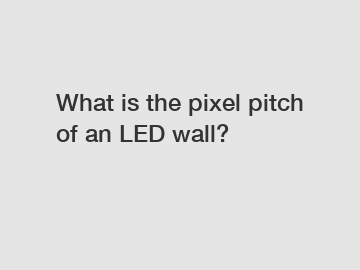LED walls have become increasingly popular in various industries, from entertainment venues to advertising displays. One crucial factor that determines the quality of an LED wall is its pixel pitch. But what exactly is the pixel pitch of an LED wall, and why does it matter? In this article, we will explore the concept of pixel pitch in LED walls and its significance in determining display quality.
**What is Pixel Pitch?**.
Pixel pitch refers to the distance between the center of one pixel to the center of the adjacent pixel on an LED display. It is measured in millimeters and plays a significant role in determining the resolution and clarity of the screen. A smaller pixel pitch indicates a higher pixel density, resulting in a sharper and more detailed image.

**Pixel Pitch and Resolution**.
The pixel pitch of an LED wall directly impacts its resolution, with a smaller pixel pitch corresponding to a higher resolution. For example, a display with a pixel pitch of 2mm will have a higher resolution than a display with a pixel pitch of 5mm. This means that images and content displayed on an LED wall with a smaller pixel pitch will appear sharper and more vibrant.
**Viewing Distance**.
Another crucial factor influenced by pixel pitch is the optimal viewing distance. LED walls with a smaller pixel pitch are suitable for viewing up close, such as in indoor settings or interactive displays. On the other hand, LED walls with a larger pixel pitch are more suitable for viewing from a distance, such as outdoor billboards or large-scale displays.
**Impact on Image Quality**.
The pixel pitch of an LED wall directly affects the overall image quality. A smaller pixel pitch results in a higher pixel density, preventing individual pixels from being visible to the naked eye. This creates a seamless and high-definition image, making it ideal for applications where image clarity is paramount.
Conversely, a larger pixel pitch may lead to pixilation or a grainy appearance, especially when viewing the display up close. This can compromise the visual appeal of the content being displayed and may not be suitable for applications that require high image quality.
**Choosing the Right Pixel Pitch**.
When selecting an LED wall, it is crucial to consider the intended use case and viewing distance to determine the appropriate pixel pitch. For indoor displays or applications requiring close viewing, a smaller pixel pitch is recommended to ensure high image quality. Alternatively, outdoor displays or applications with a larger viewing distance may benefit from a larger pixel pitch to maintain visibility and clarity.
In conclusion, the pixel pitch of an LED wall is a critical factor that influences resolution, image quality, and viewing distance. By understanding the relationship between pixel pitch and display quality, businesses and organizations can make informed decisions when investing in LED walls for various applications.
If you are considering purchasing an LED wall and need guidance on choosing the right pixel pitch for your needs, contact us for expert advice and assistance.
Contact us for all your LED wall needs and let us help you find the perfect solution for your display requirements.
Are you interested in learning more about commercial digital signage displays, lcd video wall manufacturer, advertising display solutions? Contact us today to secure an expert consultation!



Comments
All Comments (0)